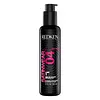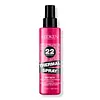What's inside
What's inside
 Key Ingredients
Key Ingredients

 Benefits
Benefits

 Concerns
Concerns

 Ingredients Side-by-side
Ingredients Side-by-side

Water
Skin ConditioningPropylene Glycol
HumectantDimethicone
EmollientAmodimethicone
Isopropyl Myristate
EmollientTriethanolamine
BufferingPhenoxyethanol
PreservativeParfum
MaskingPEG-40 Hydrogenated Castor Oil
EmulsifyingPEG/PPG-17/18 Dimethicone
EmulsifyingCarbomer
Emulsion StabilisingPolyquaternium-4
Polyquaternium-6
Potato Starch Modified
Hydroxypropyl Guar
Emulsion StabilisingCaprylyl Glycol
EmollientDimethiconol
EmollientTocopheryl Acetate
AntioxidantXylose
HumectantTrideceth-6
EmulsifyingCetyl Alcohol
EmollientBenzophenone-4
UV AbsorberQuaternium-87
CleansingBehentrimonium Methosulfate
Cetrimonium Chloride
AntimicrobialQuaternium-33
Vaccinium Macrocarpon Seed Oil
Skin Conditioning2-Oleamido-1,3-Octadecanediol
Skin ConditioningHydroxyisohexyl 3-Cyclohexene Carboxaldehyde
MaskingBenzyl Alcohol
PerfumingCitronellol
PerfumingWater, Propylene Glycol, Dimethicone, Amodimethicone, Isopropyl Myristate, Triethanolamine, Phenoxyethanol, Parfum, PEG-40 Hydrogenated Castor Oil, PEG/PPG-17/18 Dimethicone, Carbomer, Polyquaternium-4, Polyquaternium-6, Potato Starch Modified, Hydroxypropyl Guar, Caprylyl Glycol, Dimethiconol, Tocopheryl Acetate, Xylose, Trideceth-6, Cetyl Alcohol, Benzophenone-4, Quaternium-87, Behentrimonium Methosulfate, Cetrimonium Chloride, Quaternium-33, Vaccinium Macrocarpon Seed Oil, 2-Oleamido-1,3-Octadecanediol, Hydroxyisohexyl 3-Cyclohexene Carboxaldehyde, Benzyl Alcohol, Citronellol
Water
Skin ConditioningAlcohol Denat.
AntimicrobialVa/Crotonates/Vinyl Neodecanoate Copolymer
Octylacrylamide/Acrylates/Butylaminoethyl Methacrylate Copolymer
Crotonic Acid/Vinyl C8-12 Isoalkyl Esters/Va/Bis-Vinyldimethicone Crosspolymer
Cera Alba
EmollientAminomethyl Propanol
BufferingPhenoxyethanol
PreservativeParfum
MaskingPEG-30 Glyceryl Stearate
EmulsifyingXylose
HumectantHydrogenated Styrene/Butadiene Copolymer
Ethylhexylglycerin
Skin ConditioningBenzyl Salicylate
PerfumingBenzophenone-4
UV AbsorberBenzyl Alcohol
PerfumingLinalool
PerfumingHexyl Cinnamal
PerfumingMek
PerfumingDisodium Stearoyl Glutamate
CleansingVaccinium Macrocarpon Seed Oil
Skin Conditioning2-Oleamido-1,3-Octadecanediol
Skin ConditioningAlpha-Isomethyl Ionone
PerfumingCitronellol
PerfumingHydroxycitronellal
PerfumingLimonene
PerfumingBenzyl Benzoate
AntimicrobialTocopherol
AntioxidantWater, Alcohol Denat., Va/Crotonates/Vinyl Neodecanoate Copolymer, Octylacrylamide/Acrylates/Butylaminoethyl Methacrylate Copolymer, Crotonic Acid/Vinyl C8-12 Isoalkyl Esters/Va/Bis-Vinyldimethicone Crosspolymer, Cera Alba, Aminomethyl Propanol, Phenoxyethanol, Parfum, PEG-30 Glyceryl Stearate, Xylose, Hydrogenated Styrene/Butadiene Copolymer, Ethylhexylglycerin, Benzyl Salicylate, Benzophenone-4, Benzyl Alcohol, Linalool, Hexyl Cinnamal, Mek, Disodium Stearoyl Glutamate, Vaccinium Macrocarpon Seed Oil, 2-Oleamido-1,3-Octadecanediol, Alpha-Isomethyl Ionone, Citronellol, Hydroxycitronellal, Limonene, Benzyl Benzoate, Tocopherol
Ingredients Explained
These ingredients are found in both products.
Ingredients higher up in an ingredient list are typically present in a larger amount.
We don't have a description for 2-Oleamido-1,3-Octadecanediol yet.
Benzophenone-4 is a water-soluble chemical sunscreen.
It protects in the UV-B range, but is considered a secondary UV absorber. This means that it needs to be paired with other sunscreen ingredients to provide effective protection.
Typically, it's used in cosmetic products to protect them from deterioration caused by UV rays. This is why you'll find it in a lot of products that aren't sunscreens.
Learn more about Benzophenone-4Benzyl Alcohol is most commonly used as a preservative. It also has a subtle, sweet smell. Small amounts of Benzyl Alcohol is not irritating and safe to use in skincare products. Most Benzyl Alcohol is derived from fruits such as apricots.
Benzyl Alcohol has both antibacterial and antioxidant properties. These properties help lengthen the shelf life of products. Benzyl Alcohol is a solvent and helps dissolve other ingredients. It can also improve the texture and spreadability.
Alcohol comes in many different forms. Different types of alcohol will have different effects on skin. This ingredient is an astringent alcohol.
Using high concentrations of these alcohols are drying on the skin. They may strip away your skin's natural oils and even damage your skin barrier. Astringent alcohols may also irritate skin.
Other types of astringent alcohols include:
According to the National Rosacea Society based in the US, you should be mindful of products with these alcohols in the top half of ingredients.
Any type of sanitizing product will have high amounts of alcohol to help kill bacteria and viruses.
Learn more about Benzyl AlcoholCitronellol is used to add fragrance/parfum to a product. It is often derived from plants such as roses. In fact, it can be found in many essential oils including geranium, lavender, neroli, and more. The scent of Citronellol is often described as "fresh, grassy, and citrus-like".
Since the Citronellol molecule is already unstable, Citronellol becomes irritating on the skin when exposed to air.
Citronellol is a modified terpene. Terpenes are unsaturated hydrocarbons found in plants. They make up the primary part of essential oils.
Citronellol is not able to be absorbed into deeper layers of the skin. It has low permeability,
Citronellol is also a natural insect repellent.
Learn more about CitronellolParfum is a catch-all term for an ingredient or more that is used to give a scent to products.
Also called "fragrance", this ingredient can be a blend of hundreds of chemicals or plant oils. This means every product with "fragrance" or "parfum" in the ingredients list is a different mixture.
For instance, Habanolide is a proprietary trade name for a specific aroma chemical. When used as a fragrance ingredient in cosmetics, most aroma chemicals fall under the broad labeling category of “FRAGRANCE” or “PARFUM” according to EU and US regulations.
The term 'parfum' or 'fragrance' is not regulated in many countries. In many cases, it is up to the brand to define this term.
For instance, many brands choose to label themselves as "fragrance-free" because they are not using synthetic fragrances. However, their products may still contain ingredients such as essential oils that are considered a fragrance by INCI standards.
One example is Calendula flower extract. Calendula is an essential oil that still imparts a scent or 'fragrance'.
Depending on the blend, the ingredients in the mixture can cause allergies and sensitivities on the skin. Some ingredients that are known EU allergens include linalool and citronellol.
Parfum can also be used to mask or cover an unpleasant scent.
The bottom line is: not all fragrances/parfum/ingredients are created equally. If you are worried about fragrances, we recommend taking a closer look at an ingredient. And of course, we always recommend speaking with a professional.
Learn more about ParfumPhenoxyethanol is a preservative that has germicide, antimicrobial, and aromatic properties. Studies show that phenoxyethanol can prevent microbial growth. By itself, it has a scent that is similar to that of a rose.
It's often used in formulations along with Caprylyl Glycol to preserve the shelf life of products.
Vaccinium Macrocarpon Seed Oil is created from the seeds of the North American cranberry plant. This plant is native to eastern Canada.
Cranberry seed oil has antioxidant, anti-inflammatory, and hydrating properties.
Due to its high linolenic acid, linoleic acid, and oleic acid content, cranberry seed oil is an effective emollient. Emollients help hydrate the skin by creating a film on the skin. This barrier prevents moisture from escaping. Linolenic acid also has anti-inflammatory properties.
Cranberry seeds also contain Vitamin E and Vitamin C, both potent antioxidants.
Learn more about Vaccinium Macrocarpon Seed OilWater. It's the most common cosmetic ingredient of all. You'll usually see it at the top of ingredient lists, meaning that it makes up the largest part of the product.
So why is it so popular? Water most often acts as a solvent - this means that it helps dissolve other ingredients into the formulation.
You'll also recognize water as that liquid we all need to stay alive. If you see this, drink a glass of water. Stay hydrated!
Learn more about WaterWe don't have a description for Xylose yet.